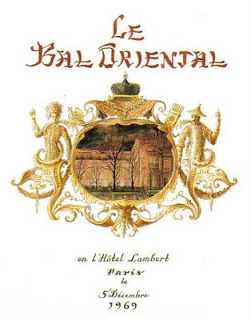Elegance. Is it an old fashioned word from a bygone era? Does elegance still exist? Does anyone now even want to look elegant? Be called elegant? Just yesterday I saw a very elegant woman in Whole Foods. It almost comes as a surprise when you seen an elegant woman because it is so unexpected. I would describe Daphne Guinesses' look as elegance with an edge. She makes an effort. Everything is done, hair, make up, the clothes. It is a rigorous kind of style and beauty. On holiday I was reading Amy Fine Collins article on Jacqueline de Ribes. I was struck by her beauty, her independence and her elegance.
La Comtesse: Jacqueline de Ribes. Weekend Reading for you from RARE vintage. Read on...
Legendary Parties:
On the evening of December 5, 1969, the beau monde was assembling for dinners at the most elegant tables in Paris for the fancy-dress party of the year, if not the decade—Baron Alexis de Redé’s “Bal Oriental.”
Among the most impenetrable of these preparatory gatherings was that of the Duke and Duchess of Windsor, the international jet set’s de facto king and queen. Dining with the elect at the Windsors’ that night was couturier Oscar de la Renta. “The first course, the second course, the third course, and finally dessert arrived,” de la Renta recalls, “and still Jacqueline de Ribes had not appeared. The Duke was furious!”
Suddenly the dining-room doors opened, and in glided the Vicomtesse de Ribes. An exotic vision, the aristocratic beauty was swaddled from the pinnacle of her tasseled hat to the tips of her pointed slippers in a fantastically opulent Turkish disguise, ingeniously cobbled together by the Vicomtesse herself from three of her old haute couture dresses; organza lamé from a remnant market; and a sable cape, acquired from an impoverished ballerina.
Jacqueline de Ribes and Douglas Fairbanks Jr at the Bal Oriental
Recalls de la Renta, “It was a show. And she was the star. No one knew like Jacqueline the power of an entrance.”
Jacqueline de Ribes, Aristotle Onassis and Elizabeth Taylor at the Bal Oriental
Alexandre Serebriakoff's illustration of the Bal Oriental
Lanky and long-nosed, Jacqueline, who would later be compared by Yves Saint Laurent to “an ivory unicorn,” was regularly mocked by her mother, Paule—an intellectual who translated Hemingway—for her unusual features and for her aspiration to become a ballerina. “My mother kissed me just once in my childhood,” Jacqueline notes. “I had the feeling always of being insecure—so I was always bumping my soul and my head.”
"When you overcome a terrible childhood, you are ready for life. That way you are already familiar with disappointment.”
In her 18th summer, Jacqueline attended a luncheon party at the house of an acquaintance in Saint-Jean-de-Luz, not far from Hendaye on the Côte Basque. “In 1947,” Jacqueline explains, “you still needed tickets to buy extra clothes.” The young man, Vicomte Édouard de Ribes, a 24-year-old war hero, had used his rations “to buy the ugliest things possible in the Basque country. But he made me laugh.” Édouard remembers, “I saw this gazelle and immediately fell in love.”
At the time of their marriage, in February 1948, Jacqueline owned only two dresses. “I had never worn makeup, never gone to a hairdresser, never worn heels,” Jacqueline recalls. “Yves Saint Laurent used to say that every time you make a choice you die a little.… I had been so unhappy as a little girl. I thought marriage had to be better—but it was not better, it was worse. I had the feeling of being loved but not understood.” Early on, when they were walking on the Champs-Élysées, she took Édouard’s hand. He shook it loose, with the rebuff, “Don’t be common.”
At a masquerade party, Jacqueline danced with an old grey haired man with blue eyes. The elderly gentleman riveted by the ethereal sylph was the flamboyant Franco-Mexican taste-maker Carlos (Charles) de Beistegui. A formidable collector of fine houses, furniture, and women, he had just bought and refurbished the Tiepolo-adorned Palazzo Labia, in Venice, and had international society madly scrambling to prepare for his inaugural “Fête des Fêtes” there. “So that is how I received an invitation to the famous Beistegui Ball,” Jacqueline says.
Charles de Beistegui
Says her great longtime friend Reinaldo Herrera, “Jacqueline told me that she had learned to lie from Charlie Beistegui.” Jacqueline explains, “Beistegui was amoral and a great snob. Beistegui taught me the complexity of social life. I had seen so much during the war, but I was innocent.”
To multiply, as in a hall of mirrors, her already dazzling image, Jacqueline enlisted two Italian noblewomen, the Princesses Caetani and Colonna, to dress identically to herself, in the manner of the painter Longhi, in white dresses, full black face masks, and fantasy jewels by Mme. Gripoix, supplier to Chanel. “We arrived by gondolas,” Jacqueline says.
Baron Alexis de Redé (The lover of Arturo Lopez-Wilshaw)
Jacques Fath and his wife
Daisy Fellowes as La Reine d'Afrique
To be continued...
Text from Amy Fine Collins article, The Last Queen of Paris. Vanity Fair. Some photos from scalaregia.blogspot
Text from Amy Fine Collins article, The Last Queen of Paris. Vanity Fair. Some photos from scalaregia.blogspot









No comments:
Post a Comment